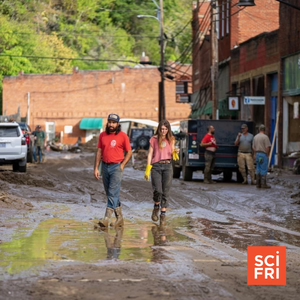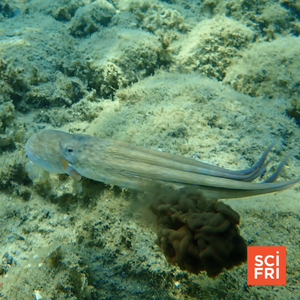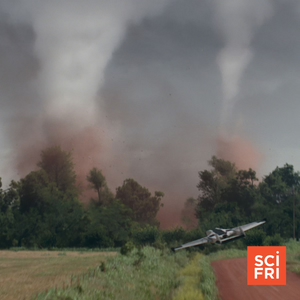
Science Friday
Science Friday and WNYC Studios



104 Listeners
1 Comment
All episodes
Best episodes
Top 10 Science Friday Episodes
Goodpods has curated a list of the 10 best Science Friday episodes, ranked by the number of listens and likes each episode have garnered from our listeners. If you are listening to Science Friday for the first time, there's no better place to start than with one of these standout episodes. If you are a fan of the show, vote for your favorite Science Friday episode by adding your comments to the episode page.

Asheville Was Never A ‘Climate Haven.’ Nowhere Is.
Science Friday
10/14/24 • 18 min
For years, Asheville, North Carolina, has been billed as a “climate haven,” a place safe from the touch of climate change-exacerbated disasters. But last month, Hurricane Helene called that label into question. Some of the worst damage of the storm occurred inland, in Western North Carolina.
Data visualization designer David McConville lived in Asheville for about 20 years, before moving to California.
“Watching people idealize Asheville was a little bit crazy-making,” McConville says. “There were very clear patterns of the combination of the topography and hydrology, weather patterns, and development patterns that were creating these dangers,” he says, referring to the extreme flooding and damage brought on by Hurricane Helene.
Resilience and adaptation for communities hit hard by storms is a huge area of conversation for cities. And for places hit hard consecutively, like Florida’s coast after Hurricanes Helene and Milton, that need is even more pressing. Joining Ira to talk about this is Dr. Jesse Keenan, associate professor of sustainable real estate and urban planning at Tulane University in New Orleans, Louisiana; and Dr. Jola Ajibade, associate professor of environmental and climate justice at Emory University in Atlanta, Georgia.
Transcripts for each segment will be available after the show airs on sciencefriday.com.
Subscribe to this podcast. Plus, to stay updated on all things science, sign up for Science Friday's newsletters.



55 Listeners
1 Comment
1

Why People Can’t Read Bar Graphs, First Complete Human Genome Released, Mars Book Club Finale. April 1, 2022, Part 2
Science Friday
04/01/22 • 47 min
Can You Read A Bar Graph?
Bar graphs seem like one of the simplest ways to represent data. Many people assume that the longer the bar, the bigger the number it represents. Sometimes bar graphs represent an average not a total count, which is trickier to understand.
And because bar graphs are everywhere, psychologists from Wellesley College wanted to determine how well people can actually read and interpret bar graphs. Turns out, one in five people in their study misunderstood the data the bar graphs intended to show. And sometimes simple-looking graphs actually make it harder to understand the data they are based on.
Ira talks with Jeremy Wilmer, associate professor, and Sarah Horan Kerns, research associate, at Wellesley College’s department of psychology, based in Wellesley Massachusetts about their bar graph research and curriculum to improve data literacy.
Scientists Release The First Fully Complete Human GenomeTwo decades ago, scientists announced they had sequenced the human genome. What you might not know is that there were gaps in that original sequence—about 8% was completely blank.
Now, after a years-long global collaboration, scientists have finally released the first fully complete assembly of the human genome. Researchers believe these missing pieces might be the key to understanding how DNA varies between people.
Six scientific papers on the topic were published in a special edition of the academic journal Science this week.
Ira talks with Karen Miga and Adam Phillippy, co-founders of the Telomere to Telomere Consortium, an international effort that led to the assembly of this new fully complete human genome.
Karen Miga is an assistant professor of bimolecular engineering and the associate director of the UC Santa Cruz Genomics Institute, based in Santa Cruz California. Adam Phillippy is head of the Genome Informatics Section and senior investigator in the computational and statistical genomics branch at the National Human Genome Research Institute at the National Institutes of Health, based in Bethesda, Maryland.
One Last Martian Love FestAfter a month of non-stop Mars science, what questions do you still have about the Red Planet? SciFri producer Christie Taylor and co-host Stephanie Sendaula interview planetary scientist and Sirens of Mars author Sarah Stewart Johnson. Plus, they take your questions about the planet’s poles, its magnetic field, and the progress of the Perseverance rover.


7 Listeners

Why Do Cephalopods Make Ink?
Science Friday
06/18/24 • 18 min
The most wonderful time of the year has arrived: Cephalopod Week, Science Friday’s annual tradition of spotlighting all things octopus, squid, and cuttlefish.
One of the many things that make cephalopods special is their ink. What’s it made of? Why do they shoot it at their predators? And why did they evolve this incredible skill?
To talk all about inking, guest host Annie Minoff is joined by Dr. Lauren Simonitis, research and biological imaging specialist at Florida Atlantic University.
Learn more about how to get involved in Cephalopod Week!
Transcript for this segment will be available after the show airs on sciencefriday.com.
Subscribe to this podcast. Plus, to stay updated on all things science, sign up for Science Friday's newsletters.
4 Listeners

07/19/24 • 24 min
The foot-long meteor passed through the Earth’s atmosphere near the Statue of Liberty. Don’t worry, it was fine. Also, the follow-up to the 1996 movie “Twister” is a whirlwind of tornado science. A weather expert decodes its lingo—and real-life tornado trends.
A Small Meteor Blazes Over New York City
Tuesday morning, some New York area residents heard a loud boom and saw a daytime fireball streaking overhead. According to observers, a small meteor entered the Earth’s atmosphere over New York City, passed by the Statue of Liberty, and proceeded west to New Jersey, moving at some 38,000 miles per hour. Meteor experts said that the object, estimated to be around a foot in size, posed no threat, as debris from an object that small would have burned up before reaching the ground.
Science Friday’s Charles Bergquist joins guest host Rachel Feltman to talk about the overhead display, and about other science news from the week, including a newly planned mission to fly by a near-Earth asteroid. They’ll also talk about a new pool of data for human genetics research, efforts to predict rogue waves, and the challenges of making food taste right in orbit.
The Tornado Science To Know Before Seeing ‘Twisters’
“Twisters,” the long awaited follow-up to the 1996 movie “Twister” drops in theaters today, July 19. It’s about a scientist (Daisy Edgar-Jones) who goes back to her home state of Oklahoma to try and stop a massive tornado outbreak from wreaking havoc on its citizens. On the way, she meets a quirky cast of storm chasers, and butts heads with a band of unorthodox “tornado wranglers” led by a YouTube personality (Glen Powell). “Twisters” delights in name-dropping tornado jargon, and its science advisory team said they hoped to make the movie as accurate as possible.
The movie makes science thrilling, but it also shows the ways that tornadoes affect people’s lives in the real world. For example, earlier this week, the Chicago area was hit with multiple tornadoes during a night of extreme weather, leaving thousands without power, and four tornadoes hit upstate New York, killing one person. This comes after a powerful, and some say unusual, tornado season in the Midwest. But just how tornadoes will continue to change is still unknown.
Digital producer Emma Gometz talks with Dr. Bill Gallus, a meteorology professor at Iowa State University, to decode some of the science from “Twisters” and understand how real-life tornadoes are changing.
Transcripts for each segment will be available after the show airs on sciencefriday.com.
Subscribe to this podcast. Plus, to stay updated on all things science, sign up for Science Friday's newsletters.


4 Listeners

03/28/25 • 24 min
The company has genetic data of 15 million people, which could be shared with a future buyer. Here’s how to delete it. Plus, an experimental coating could make golf balls roll more reliably on greens with different conditions.
After 23andMe Bankruptcy, Customers Urged To Delete Their Data
If you’re one of roughly 15 million people who used 23andMe to unlock information from their DNA, consumer advocates have a message for you: Delete your data. On Sunday, the company, which has customers send saliva samples for DNA analysis, filed for bankruptcy. While many customers submitted their saliva for the purpose of ancestral analysis, 85% of customers also consent to their data used for genetic disease research.
As the company searches for a buyer, consumer advocates, including California Attorney General Rob Bonta, have urged customers to delete their data from 23andMe’s website. 23andMe and other genetic testing companies are not subject to HIPAA, meaning health and medical records kept by 23andMe could be shared with a future buyer.
Producer Kathleen Davis joins Host Flora Lichtman to discuss this and other top science stories of the week.
Chemists Make A Coating That Can Slow A Golf Ball’s Roll
With spring here, the days are getting warmer and longer, meaning conditions are perfect for a trip to the golf course. And while golf is certainly a game of physics—force, angles, parabolas—this week researchers presented work showing that chemistry could play an important role on the golf course as well. Speaking at the meeting of the American Chemical Society in San Diego, researchers described a high performance coating that could be incorporated into the polyurethane shell of a golf ball.
The hydrophilic (water-loving) coating would make tiny bits of water stick to the surface of the golf ball and sheet off, modifying the way the ball interacts with the grass of the green. That interaction, says Tom Kennedy, owner of Chemical Innovative Solutions Inc., would lead to the ball rolling more slowly and reliably, especially on “fast,” closely-cut greens in dry and windy conditions.
Kennedy joins Host Ira Flatow to discuss the technology, and how hydrophilic coatings could find a home in other applications, including solar cells.
Transcripts for each segment will be available after the show airs on sciencefriday.com.
Subscribe to this podcast. Plus, to stay updated on all things science, sign up for Science Friday's newsletters.


4 Listeners

What Makes ‘SuperAgers’ Stay Healthy For So Long?
Science Friday
10/15/24 • 17 min
A common worry among older adults is how their brains and bodies might decline as they age.
A small but fortunate group will live past their 95th birthdays, while staying cognitively sharp and free of major health complications. They’re called “SuperAgers.”
Researchers are working to figure out some of the genetic factors behind SuperAgers’ longevity—and how that knowledge might help the rest of the population live longer and healthier lives.
Ira talks with Dr. Sofiya Milman, director of Human Longevity Studies at Albert Einstein College of Medicine and the lead researcher of the SuperAgers Family Study; and one of the study’s participants, Sally Froelich, a 95-year-old New York resident.
Transcript for this segment will be available after the show airs on sciencefriday.com.
Subscribe to this podcast. Plus, to stay updated on all things science, sign up for Science Friday's newsletters.



4 Listeners
1 Comment
1

Why Are There So Many Drug Shortages In The U.S.?
Science Friday
07/18/24 • 33 min
If you’ve tried to get prescriptions filled in the last year or so, a pharmacist may have told you, “Sorry, we don’t have that drug right now.” That’s because there are some 323 active and ongoing drug shortages in the United States. That’s the highest number of such shortages since the American Society of Health System Pharmacists started tracking this data back in 2001.
These drug shortages touch every part of the healthcare system. Doctors are having to reconfigure their treatment plans due to short supply of certain drugs, like cancer treatments. And patients can be left going from pharmacy to pharmacy to get even the most common medications, like antibiotics.
SciFri’s John Dankosky talks with freelance journalist Indira Khera and journalist and physician Dr. Eli Cahan, who looked into why drug shortages happen, how they’re affecting the healthcare system, and what solutions are on the horizon.
Transcripts for each segment will be available after the show airs on sciencefriday.com.
Subscribe to this podcast. Plus, to stay updated on all things science, sign up for Science Friday's newsletters.

3 Listeners

Old Things Considered: La Brea, Megalodon, Dino Footprints, Surviving History. Aug 25, 2023, Part 2
Science Friday
08/25/23 • 47 min
How Early Humans May Have Transformed L.A.’s Landscape Forever
Join us on a time traveling adventure, as we go back 15,000 years to visit what’s now southern California. During the last Ice Age, saber-toothed cats, wooly mammoths, and dire wolves prowled the landscape, until ... they didn’t. The end of the Ice Age coincided with the end of these species. And for decades, scientists have been trying to figure out a big question: Why did these animals go extinct?
A new study in the journal Science offers new clues and suggests that wildfires caused by humans might’ve been the nail in these critters’ coffins.
Guest host Flora Lichtman talks with paleoecologist Dr. Emily Lindsey and paleobotanist Dr. Regan Dunn, both curators at the La Brea Tar Pits and Museum in Los Angeles, California, about what we can learn from animals preserved in tar pits, how fire transformed the ecosystem, and why we have to look to the past for modern day conservation and land management.
How Scientifically Accurate Are The Sharks In ‘Meg 2: The Trench’?
“Meg 2: The Trench” is the sequel to the 2018 movie “The Meg,” in which a team of ocean scientists discover a megalodon, the largest shark that ever lived, thriving at the bottom of the Mariana Trench. Megalodon went extinct over 2.6 million years ago ... or so the movie’s characters thought.
When the team’s research sub gets damaged, a skilled rescue diver, played by Jason Statham, is brought in, who happened to have encountered the same megalodon years earlier. Over the course of the movie, the team discovers how this long-thought extinct apex predator survived, and what they can do to stop it before it wreaks havoc on the surface world.
“Meg 2: The Trench” largely follows in that movie’s footsteps, but this time, it features not just one, but multiple megalodons. Oh, and they’re even bigger this time.
Universe of Art host D. Peterschmidt chats with Dr. Sora Kim, an associate professor of paleoecology at University of California, Merced, about what science the movie got wrong (and right) and how these over-the-top blockbusters can inspire the scientists of the future.
Scientists Discover Dinosaur ‘Coliseum’ In Alaska’s Denali National Park
Researchers recently discovered a rocky outcrop at Denali National Park in Alaska covered in dinosaur tracks, which they dubbed the “Coliseum.” It’s the largest dinosaur track site ever found in Alaska.
The area has thousands of prints from generations of dinosaurs living about 70 million years ago, including: duck-billed dinosaurs, horned dinosaurs, raptors, tyrannosaurs.
Flora Lichtman talks with Dustin Stewart, former graduate student at the University of Alaska Fairbanks and paleontologist for the environmental consulting firm Stantec, based in Denver, Colorado, about this dino hotspot.
Your Guide To Conquering History’s Greatest Catastrophes
Guest host Flora Lichtman takes us back to some of the scariest, deadliest moments in history. Think along the lines of the eruption of Mount Vesuvius, the Ice Age, and the asteroid that wiped out the dinos. But we’re going to revisit them using what we know now—and science, of course—to figure out if and how we could survive those events.
The idea of using science and hindsight to survive history is the premise of a new book, How to Survive History: How to Outrun a Tyrannosaurus, Escape Pompeii, Get Off the Titanic, and Survive the Rest of History’s Deadliest Catastrophes by Cody Cassidy.
We have a new podcast! It’s called 3 Listeners

Strain Of Bird Flu Discovered In California | Understanding Bipolar Disorder Through The Genome
Science Friday
01/31/25 • 24 min
The outbreak of H5N9 avian influenza occurred at a California duck farm in November 2024. Also, new research pinpoints 298 parts of the genome associated with higher risk of bipolar disorder. This could lead to better treatments.
Another Strain Of Bird Flu Discovered In California
This week, the World Organization for Animal Health reported that it had been notified by the USDA that a November outbreak of highly pathogenic avian influenza on a California duck farm was caused by a strain not before seen in the United States: H5N9. The dominant bird flu strain circulating currently, H5N1, has led to massive culling of bird flocks, has infected dairy cattle, and has killed almost 500 people around the world since 2003. The US reported its first human death from bird flu earlier this month.
Experts stressed that the new strain did not itself appear to be an immediate human threat. But the rise of a new strain is troubling and points to the risk of a viral phenomenon known as “reassortment,” in which different viruses mingled in a host can sometimes exchange bits of viral code, forming new strains.
SciFri’s Charles Bergquist joins Flora Lichtman to talk about H5N9 and other stories from the week in science, including a spacewalk that was meant to include a search for microbes on the outside of the International Space Station, a possible positive side effect of scratching an itch, and the discovery of 66 million-year-old fossilized vomit.
Understanding Bipolar Disorder Through The Genome
Bipolar disorder is one of the most common mental illnesses—it affects an estimated 40 million people worldwide, about 2.8% of the population. Bipolar disorder can cause extreme mood swings, and be debilitating without treatment.
In an effort to untangle the mysteries of where bipolar disorder originates, researchers studied the genomes of more than 40,000 people with the condition. When comparing these genomes to those of people without bipolar disorder, the researchers were able to pinpoint 298 different parts of the genome associated with the mental illness. With this better understanding of the genome, better, more targeted treatments for bipolar disorder may be possible.
Joining Flora to talk about this research is Dr. Niamh Mullins, assistant professor of psychiatric genomics at the Icahn School of Medicine at Mount Sinai in New York.
Transcripts for each segment will be available after the show airs on sciencefriday.com.
Subscribe to this podcast. Plus, to stay updated on all things science, sign up for Science Friday's newsletters.

3 Listeners

12/18/24 • 18 min
Sitting is a big part of modern life. Many people work at a desk all day, have long commutes, or at least enjoy some time relaxing on the couch at the end of the day. But sitting has gained a reputation as being bad for us—with some going so far as to call it “the new smoking.”
A recent study in the journal PLOS One sheds more light on just how much sitting is too much, using a cohort of more than 1,000 young adults, including 730 twins. The results showed that sitting for more than about eight and a half hours per day is linked to a higher total cholesterol and body mass index than sitting for less than that amount of time.
But there’s good news: 30 minutes of vigorous exercise per day may counter the negative effects that come from long days of sitting.
Joining guest host Kathleen Davis to discuss the findings are two of the study authors: Dr. Chandra Reynolds, professor in the Institute of Behavioral Genetics at the University of Colorado, Boulder; and Ryan Bruellman, PhD candidate in genetics, genomics, and bioinformatics at the University of California, Riverside.
Transcripts for each segment will be available after the show airs on sciencefriday.com.
Subscribe to this podcast. Plus, to stay updated on all things science, sign up for Science Friday's newsletters.

3 Listeners
Show more best episodes

Show more best episodes
Featured in these lists
FAQ
How many episodes does Science Friday have?
Science Friday currently has 797 episodes available.
What topics does Science Friday cover?
The podcast is about Life Sciences, Natural Sciences, Podcasts, Wnyc and Science.
What is the most popular episode on Science Friday?
The episode title 'Asheville Was Never A ‘Climate Haven.’ Nowhere Is.' is the most popular.
What is the average episode length on Science Friday?
The average episode length on Science Friday is 33 minutes.
How often are episodes of Science Friday released?
Episodes of Science Friday are typically released every day.
When was the first episode of Science Friday?
The first episode of Science Friday was released on May 29, 2020.
Show more FAQ

Show more FAQ
Comments
@guerrymcclellan
Jun 18
1 Like
Reply
